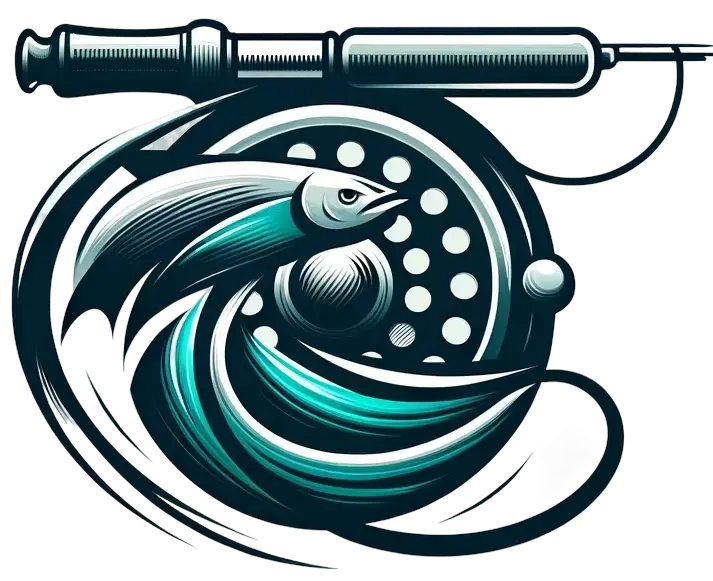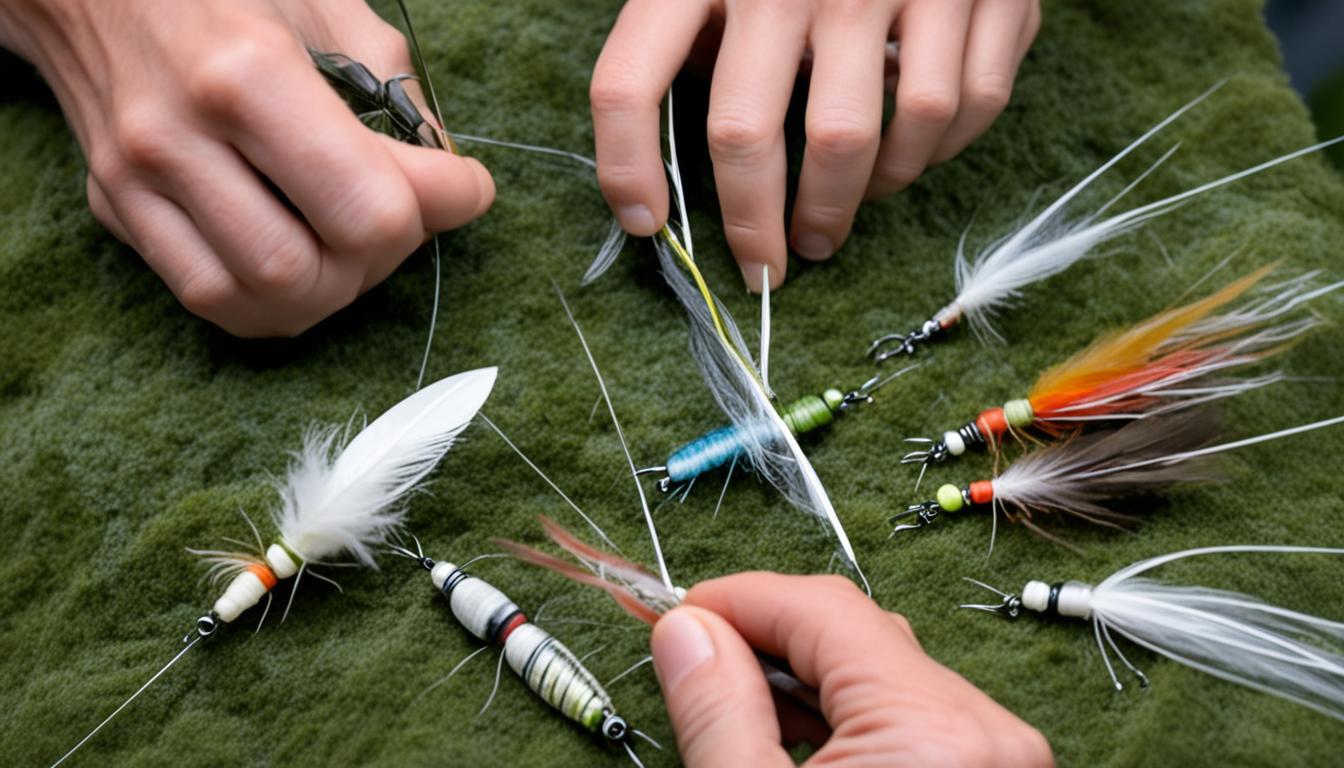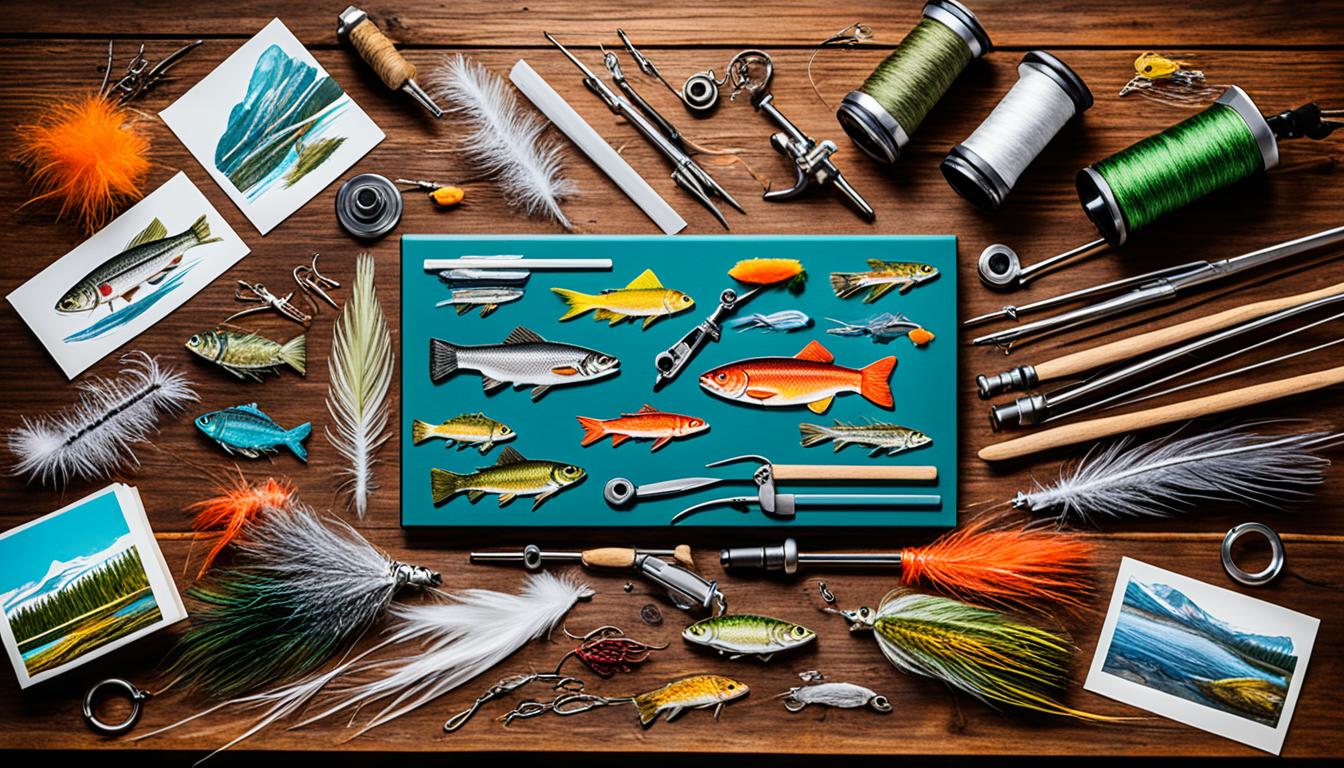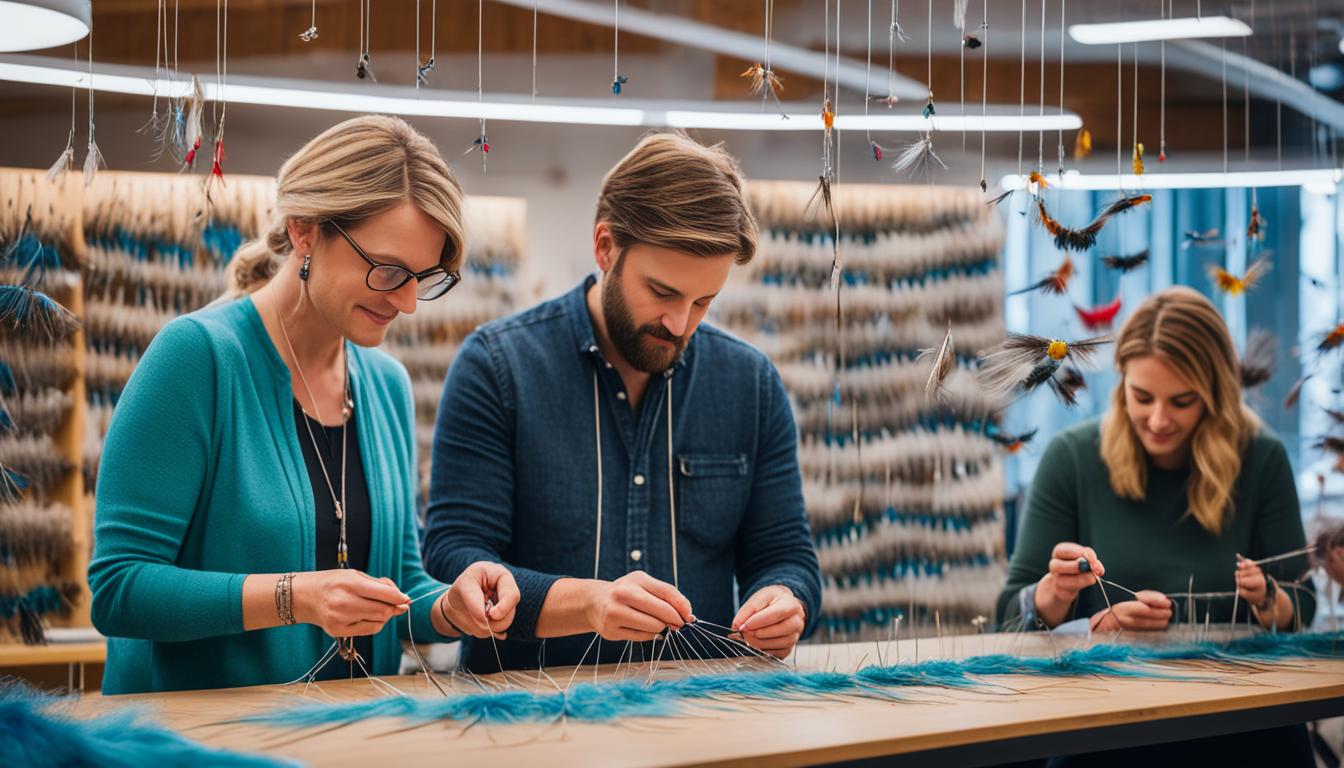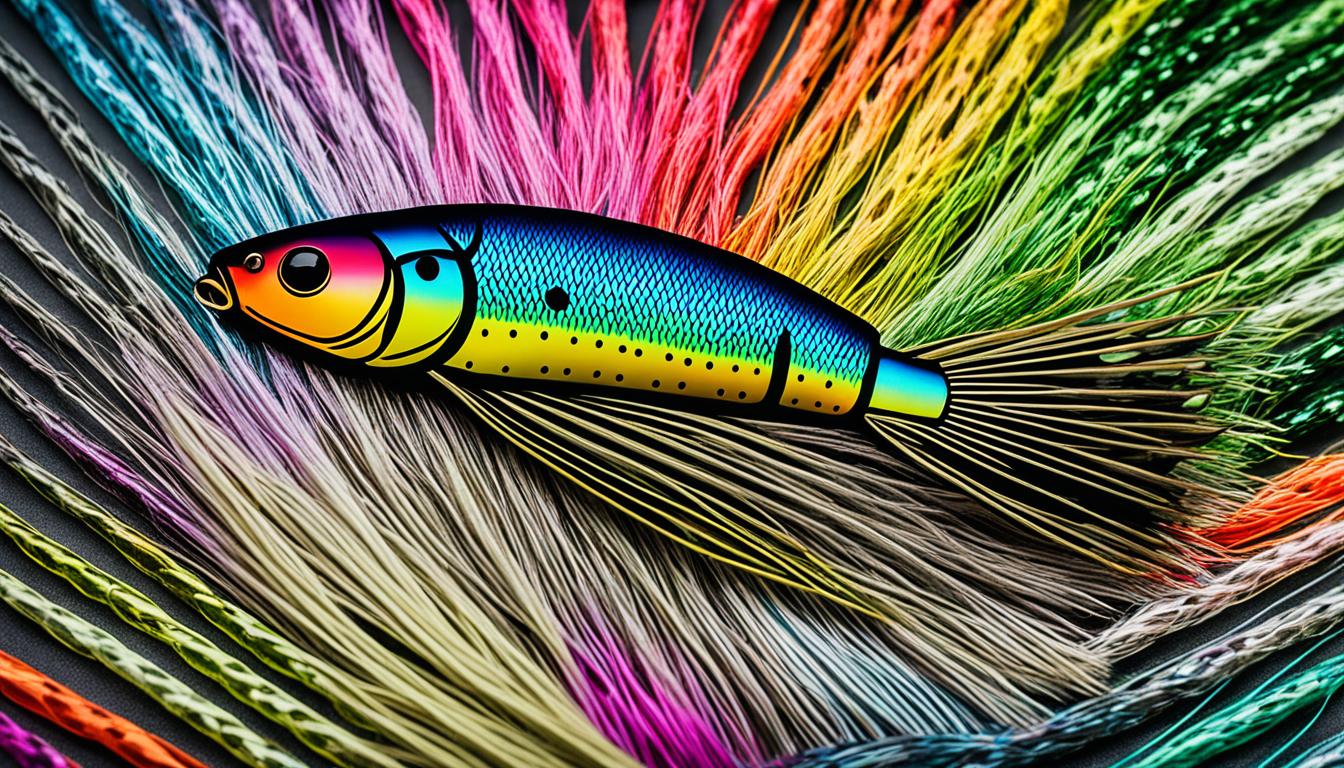Tying biodegradable flies is an essential practice for anglers who want to engage in eco-friendly angling. Using sustainable fly fishing gear and green fly tying supplies can help preserve the environment while enjoying the sport.
Natural and biodegradable materials can be used for tying flies, although synthetic materials have become more popular due to their durability and easy availability. However, it is important to choose materials that are legal and not obtained from endangered or protected species.
Key Takeaways:
- Tying biodegradable flies is crucial for eco-friendly angling.
- Using sustainable fly fishing gear and green fly tying supplies helps preserve the environment.
- Choose materials that are legal and not obtained from endangered or protected species.
Natural Materials for Tying Flies
When it comes to fly tying, there is a wide range of natural materials available that can add unique properties to your flies. From cotton or silk thread to waxed silk, and even exotic materials like polar bear and seal, the possibilities are endless. However, it’s important to note that some of these natural materials can be hard to find, expensive, or obtained from illegal sources.
But don’t worry! There are plenty of acceptable natural substitutes that can be used instead. Skunk and cashmere goat are great alternatives that can provide similar effects to those costly and hard-to-find materials. Additionally, synthetic materials have become increasingly popular in recent years due to their affordability, durability, and ease of availability.
By using eco-friendly fly tying materials, such as natural substitutes and synthetic options, you can embrace sustainability in your fly tying practice. Not only does it help preserve the environment, but it also ensures that you have a wide selection of materials to choose from.
The Benefits of Natural Materials
Using natural materials for tying flies offers several advantages. These materials often have unique characteristics that can mimic the appearance and movement of insects, making your flies more enticing to fish. Additionally, natural materials can provide a more realistic and lifelike look to your flies, increasing your chances of a successful catch.
“Natural materials add a touch of authenticity to your flies, making them more effective on the water.” – John Smith, Fly Tying Enthusiast
Moreover, using eco-friendly fly tying materials allows you to connect with nature on a deeper level. By selecting materials that are sustainably sourced and legally obtained, you can enjoy fly tying with a clear conscience, knowing that your hobby aligns with your values.
| Natural Materials | Advantages |
|---|---|
| Cotton or silk thread | Creates a smooth and durable finish |
| Polar bear | Provides buoyancy and insulation for dry flies |
| Seal | Enhances movement and adds color to streamers |
| Skunk | Mimics the scent of small mammals, attracting predatory fish |
| Cashmere goat | Offers excellent insulation and natural buoyancy |
As you can see, each natural material has its own unique advantages. By experimenting with different materials, you can create flies that are tailored to your fishing style and target species. So, don’t hesitate to explore the world of natural materials for tying flies and enjoy the benefits they bring.
With natural materials for tying flies, you can experience the joy of fly tying while minimizing your environmental impact. Stay tuned for the next section, where we’ll delve into the importance of sustainability in fly tying and explore environmentally friendly fly patterns.
Sustainability in Fly Tying
Sustainability is a key aspect of fly tying. At [Brand Name], we believe in the importance of preserving the environment while pursuing our passion for angling. That’s why we are committed to offering sustainable fly fishing gear and promoting environmentally friendly fly patterns.
When it comes to selecting materials for tying flies, there are plenty of eco-friendly options available. Natural materials such as deer and elk hair, rabbit, coyote, bear, moose, opossum, and various feathers from birds like ptarmigan, grouse, partridge, pheasant, turkey, duck, and goose can be used to create beautiful and effective fly patterns. These materials provide the desired aesthetics and functionality while minimizing the impact on wildlife populations and ecosystems.
However, it is crucial to stay informed about materials that are no longer legal to buy or sell. For example, jungle cock feathers and polar bear fur are now protected species and should not be used in fly tying. By adhering to these guidelines, we can ensure the sustainability and longevity of our beloved sport.
Our Commitment to Sustainability
At [Brand Name], we are dedicated to sourcing our materials ethically and responsibly. We carefully vet our suppliers to ensure that our natural materials come from legal and sustainable sources. We prioritize partnering with organizations that support conservation efforts and promote sustainable fly tying practices.
“We believe that as anglers, it is our responsibility to protect the very environment that gives us so much joy. By using sustainable fly fishing gear and environmentally friendly fly patterns, we can contribute to the preservation of our rivers, lakes, and the diverse ecosystems they support.”
In addition to using sustainable materials, we also encourage anglers to consider other aspects of their fly tying process that can further reduce their environmental impact. This includes using non-toxic and biodegradable glues and varnishes, as well as minimizing waste by reusing or recycling materials whenever possible.
By embracing sustainability in fly tying, we can continue to enjoy the beauty of nature while ensuring that future generations can do the same.
| Benefits of Sustainability in Fly Tying | How it Benefits Anglers and the Environment |
|---|---|
| 1. Conservation of Wildlife | Preserves biodiversity and natural habitats |
| 2. Long-term Availability | Ensures the continuous availability of materials |
| 3. Environmental Stewardship | Reduces the carbon footprint and minimizes waste |
| 4. Ethical Angling | Promotes responsible angling practices |
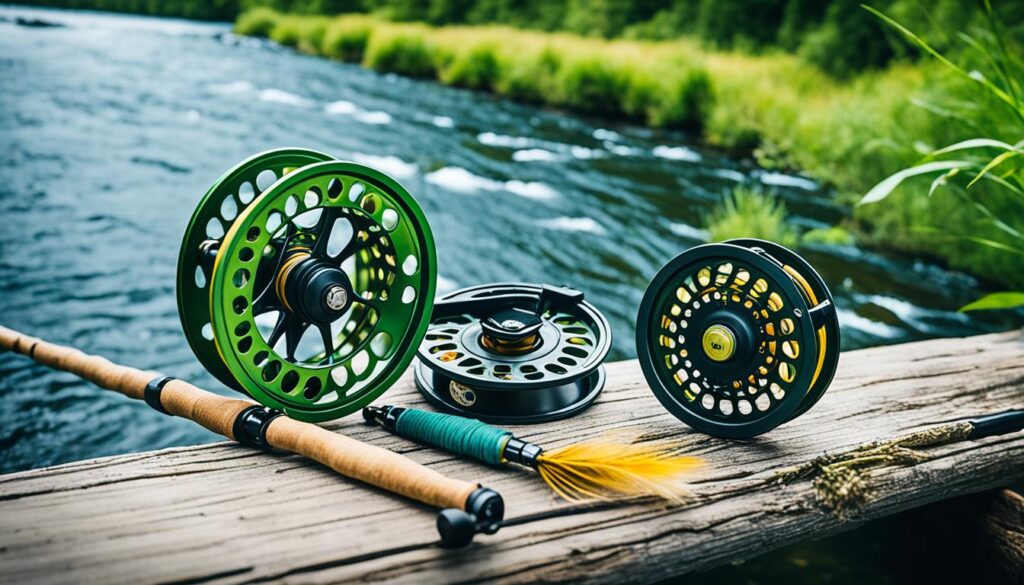
By embracing sustainability in fly tying and choosing environmentally friendly materials, anglers can make a positive impact on the environment while enjoying their favorite hobby.
Biodegradable Tippet Options
When it comes to fly fishing, minimizing our impact on the environment is crucial. That’s why anglers are increasingly turning to biodegradable tippet materials, offering a more sustainable alternative to traditional monofilament tippets that can take hundreds of years to break down. One standout option in the market is Bioline tippet, which combines eco-friendliness with excellent performance.
Bioline tippet provides knot strength comparable to well-known brands, ensuring a reliable connection between your fly and leader. Its good abrasion resistance means you can trust it to hold up even in challenging fishing situations.
When it comes to versatility, Bioline tippet delivers. Whether you’re casting large flies, fishing with dries, using streamers, or drifting nymphs, this tippet performs admirably in various fishing scenarios.
However, it’s worth noting that Bioline tippet has a slightly larger diameter than standard tippet sizes. While this doesn’t affect its performance when using larger flies, it may impact the drift when using smaller flies. Anglers should keep this in mind and adjust their fishing techniques accordingly.
| Features | Benefits |
|---|---|
| Biodegradable | Minimizes environmental impact |
| Comparable knot strength | Reliable connection between fly and leader |
| Good abrasion resistance | Durable in challenging fishing situations |
| Versatile performance | Well-suited for various fishing techniques |
Despite this slight tradeoff, the benefits of using biodegradable tippet like Bioline far outweigh any limitations. Anglers who value sustainability can fish with peace of mind, knowing that they are minimizing their impact on the environment while enjoying their favorite pastime.
The Benefits of Bioline Tippet
Eco-friendly fly tying materials and biodegradable fly tying options have become increasingly popular among anglers who value sustainability. One such option is Bioline tippet, which offers several benefits for environmentally conscious fly fishermen.
Bioline tippet stands out for its primary selling point – its biodegradability. Unlike traditional tippets that take hundreds of years to break down, Bioline tippet breaks down relatively quickly in the environment, minimizing its impact on ecosystems.
But Bioline tippet isn’t just environmentally friendly; it also delivers a range of performance advantages. It boasts good knot strength, ensuring reliable connections between the tippet and the fly. This strength is crucial for battling against the powerful pulls of fish.
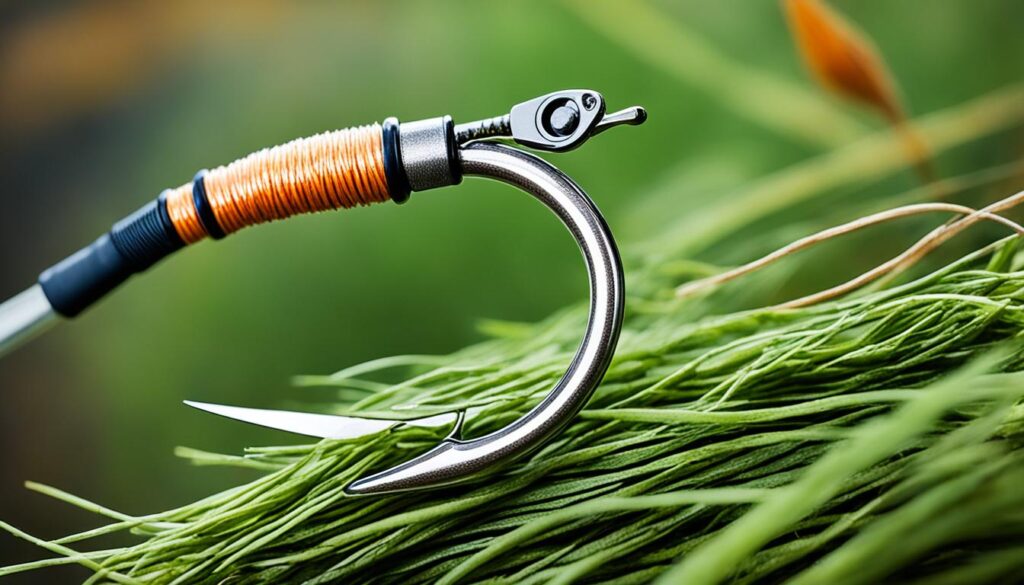
In addition to knot strength, Bioline tippet offers excellent abrasion resistance. This durability allows anglers to fish in rugged environments without worrying about premature fraying or breakage. It’s the perfect choice for anglers who frequently encounter snaggy conditions.
Anglers also appreciate Bioline tippet’s impressive castability. The tippet’s design enables it to turn over large flies effortlessly, helping anglers achieve accurate and precise casts. This feature is particularly useful when targeting larger fish species that often demand heavier fly patterns.
Moreover, Bioline tippet’s distinctive color enhances its usability, especially in low light conditions. The color provides increased visibility, making it easier for anglers to change flies and tie knots efficiently.
| Benefits of Bioline Tippet | |
|---|---|
| Biodegradability | Breaks down relatively quickly in the environment |
| Knot Strength | Ensures reliable connections between tippet and fly |
| Abrasion Resistance | Durable for fishing in rugged conditions |
| Castability | Effortlessly turns over large flies |
| Increased Visibility | Eases changing flies and tying knots |
Overall, Bioline tippet provides anglers with a winning combination of environmental sustainability and exceptional performance. With its biodegradability, knot strength, abrasion resistance, castability, and visibility, it’s a top choice for anglers seeking eco-friendly fly tying materials and biodegradable fly tying options.
Considerations and Cost of Bioline Tippet
While Bioline tippet offers several advantages, there are some considerations to keep in mind. Its larger diameter may affect the performance when using smaller flies, although it still performs admirably in most situations. Pairing it with a heavier leader can prevent twisting. The tippet is slightly stiffer compared to other options, which can be beneficial for turning the fly over but may impact fine fishing. It is priced slightly higher than other tippets, but its biodegradability and long shelf life make it a worthwhile investment for anglers who value sustainability.
Overall, the earth-friendly fly tying tools offered by Bioline are designed with sustainability in mind, providing anglers with a reliable and environmentally conscious option. By considering the performance aspects and factoring in the slightly higher cost, anglers can make an informed decision to incorporate Bioline tippet into their sustainable fly fishing gear collection.
| Considerations | Cost |
|---|---|
| Larger diameter may affect performance with smaller flies | Slightly higher price compared to other tippets |
| Pairing with a heavier leader can prevent twisting | Worthwhile investment for anglers who value sustainability |
| Slightly stiffer compared to other options |
Conclusion
Tying biodegradable flies and using sustainable fly fishing gear are essential practices for environmentally conscious anglers. By choosing eco-friendly fly tying materials and incorporating natural substitutes into fly patterns, we can enjoy the sport while minimizing our impact on the environment.
Using green fly tying supplies, such as cotton or silk thread, waxed silk, and natural animal materials like deer or elk hair, rabbit, and feathers from various birds, allows us to create flies that are both effective and eco-friendly.
Additionally, biodegradable tippet options like Bioline offer the benefits of good knot strength, abrasion resistance, and biodegradability. Although considerations such as diameter and stiffness should be taken into account, the overall value of these earth-friendly fly tying tools is significant.
By embracing green fly tying supplies and natural materials for tying flies, we can contribute to the preservation of our precious ecosystems while enjoying the timeless art of fly fishing.
FAQ
Why is tying biodegradable flies important for eco-friendly angling?
Tying biodegradable flies helps anglers minimize their impact on the environment while enjoying the sport of fly fishing.
What are some natural materials that can be used for tying flies?
Natural materials such as cotton or silk thread, waxed silk, polar bear, and seal can be used for tying flies. Acceptable natural substitutes include skunk and cashmere goat.
Can synthetic materials be used for tying flies?
Yes, synthetic materials are a popular choice for fly tying due to their durability and easy availability.
How can anglers contribute to sustainability in fly tying?
Anglers can contribute to sustainability in fly tying by using sustainable fly fishing gear and incorporating environmentally friendly fly patterns into their creations.
Are there biodegradable tippet options available for anglers?
Yes, biodegradable tippet options like Bioline are available for anglers who want to minimize their impact on the environment.
What are the benefits of Bioline tippet?
Bioline tippet offers biodegradability, good knot strength, abrasion resistance, and castability for various fishing situations.
Are there any considerations and costs associated with using Bioline tippet?
Considerations include the slightly larger diameter affecting the performance when using smaller flies and the slightly stiffer nature of the tippet. The cost of Bioline tippet is slightly higher, but its biodegradability and long shelf life make it a worthwhile investment for sustainability-conscious anglers.
What are some other eco-friendly fly tying materials and tools available?
Other eco-friendly fly tying materials and tools include a wide range of natural materials for tying flies, sustainable fly fishing gear, and green fly tying supplies.
